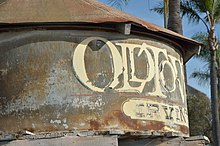
The Irvine Company, LLC. is an American private company focused on real estate development. It is headquartered in Newport Beach, California, with a large portion of its operations centered in and around Irvine, California, a planned city of about 280,000 people mainly designed by the Irvine Company. The company was founded by the Irvine family and is currently wholly owned by Donald Bren. Since the company is private, its financials are not released to the public. However, Donald Bren is the wealthiest real estate developer in the United States, with a net worth of $16.4 billion in 2019.

Old Pasadena, often referred to as Old Town Pasadena or just Old Town, is the original commercial center of Pasadena, a city in California, United States that arose from one of the most prosperous areas of the state, and had a latter day revitalization after a period of decay.
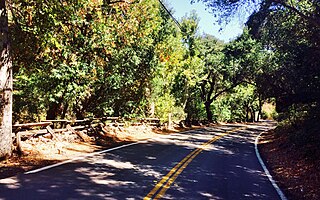
Founded in 1878, Silverado, a California Historical Landmark, is an unincorporated community in Silverado Canyon, which is located in the Santa Ana Mountains in eastern Orange County, California. Portions of the town sit on a former Mexican land grant Rancho Lomas de Santiago. Silverado is located at the boundaries of Cleveland National Forest. The area was mined for silver during the late 19th and early 20th centuries. Remnants of mining operations such as the Blue Light Mine are still scattered in the area. Timber was harvested for use by the railroad. Coal was mined at the time in Carbondale. Ancient sea life fossils can be found within the sandstone cliffs in the area. During Spanish rule, the canyon was visited by Spanish explorers and was known by the name Cañada de la Madera. The town in Spain by that name bears a remarkable resemblance to Silverado. The area enjoyed a renaissance in popularity in the 1940s as a hot springs vacation retreat, during which time hotels and restaurants prospered. Many weekend cabins were also built at that time. Home to a number of artists and craftsmen, the town now consists of about 2,000 residents, a general store, a cafe, a public library, a church, two fire stations, a community center, and a post office. It hosts summer concerts, an annual Country Fair, and an Easter breakfast. A local landmark near Silverado is Cook's Corner, a bar popular with motorcyclists.

Irvine is a master-planned city in Orange County, California, United States in the Los Angeles metropolitan area. The Irvine Company started developing the area in the 1960s and the city was formally incorporated on December 28, 1971. The 66-square-mile (170 km2) city had a population of 212,375 as of the 2010 census; in 2019, the California Department of Finance estimated the city's population at 287,401, making it the 72nd-most populous city in the United States.
Buffalo Ranch was a tourist attraction which was operated on 115 acres (0.47 km2) in what is today Newport Beach, California by Gene Clark of the Irvine Company and the grandson of the famous Indian chief Geronimo. It was the first outside business to be allowed onto land owned by The Irvine Company. The ranch began with a herd of 72 buffalo, and this number quickly grew. Several Indian families from Kansas were invited to live in the area and work at the Ranch to add to its authenticity and present various tribal dances for the tourists. Bison Road, which exists today as a connection between Jamboree and MacArthur roads in Newport Beach, was originally created as an access road to Buffalo Ranch.

Mentryville was an oil drilling town in the Santa Susana Mountains in Los Angeles County, California, USA. It was started by Charles Alexander Mentry in the 1870s around the newly discovered oil reserves in that area. The first oil strike was on September 26, 1876. The town is located at the terminus of Pico Canyon Road, four miles west of the Lyons Avenue exit from I-5 in Santa Clarita. It is currently a part of Stevenson Ranch.
The Irvine family of Southern California are a prominent Californian family of real estate developers. Through the Irvine Company, the family played an important role in the development of Orange County. The city of Irvine and the University of California, Irvine take their name from the family.

Northwood is a community encompassing the northern portions of the city of Irvine, in Orange County, California. It covers the area enclosed by the Santa Ana Freeway, Culver Drive, Portola Parkway and Jeffrey Road.

Lake City is an unincorporated community in Nevada County, California. It lies at an elevation of 3300 ft. about 10 miles northeast of Nevada City as the crow flies, and about three miles southeast of North Columbia, and three miles southwest of North Bloomfield. It is located at the junction of modern day North Bloomfield, Back Bone and Lake City Roads. It was an important mining and transportation center in the second half of the 19th century.

Cherokee is a former gold mining community in Nevada County, California. As explained below, it has also been known as Patterson, Melrose and Tyler. It is located on the San Juan Ridge about 4 miles east of North San Juan. Its elevation is 2,516 ft (767 m) above sea level.
The Empire City Historic Landmark is a California Historic Landmark in honor of the pioneer John C. Marvin who from 1850, settled on the south bank of the Tuolumne River and called the town "Empire City". Empire City was the head of navigation for small steamboats that could ascend the Tuolumne River carrying passengers and supplies. It was the shipping point for the large grain crops grown in the area. At its height, the town had three stores, a three-story hotel, two boarding houses, a blacksmith shop, a church, and a school house. Empire City was voted as the county seat of Stanislaus County from October 1854 to December 1855. The town was destroyed by flood waters during the Great Flood of 1862. A new railroad town was built 40 years later 1 mile north of the old town site, taking the name Empire.

Woodbury is a neighborhood of Irvine, California, located from Irvine Boulevard to Trabuco Road, between Jeffrey Road and Sand Canyon Avenue. Despite the similar name, Woodbury and Woodbury East are separate neighborhoods and maintain separate HOAs and amenities.
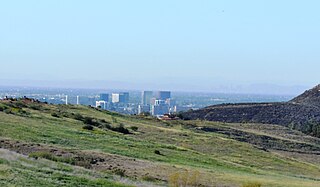
Bommer Canyon is an open space preserve in southern Irvine, California featuring hiking and biking trails as well as private event areas. The canyon is part of the Irvine Ranch, which itself is a National Natural Landmark, the first California Natural Landmark, and part of the City of Irvine Open Space Preserve. The preserve is adjacent to the affluent Irvine villages of Shady Canyon and Turtle Ridge and features roughly 16,000 acres of preserved open space. Approximately 15 of these acres are preserved as a "Cattle Camp" named for the area's previous cattle operations and are now rented for private events such as campouts, company picnics, and family reunions. The trails in Bommer Canyon feature groves of oak and sycamore trees as well as rough rock outcrops and are popular with area residents who use them for nature walks, hiking and mountain biking.

Peters Canyon Regional Park is a regional park within the Orange County Regional Parks System in California. The park contains 354 acres of southern California wildlife, including costal sage shrub, riparian, freshwater marsh, and grasslands, and is located within the boundaries of both Orange, California and Tustin, California. Peters Canyon was given to this city in 1992 by the Irvine Company who had used it previously for cattle grazing. The canyon is lined with a residential area on one side and open hills on the other. This canyon is commonly used by hikers, mountain bikers, and equestrians because of the trails that circumvent the 50 acre man-made lake, which was constructed by the Irvine Company in 1931, on the interior of the plot. The regional park is open from 7:00 AM to sunset every day of the week, save for the chance of rain or hazardous conditions, in which case the park will be closed for three days following the particular occurrence.
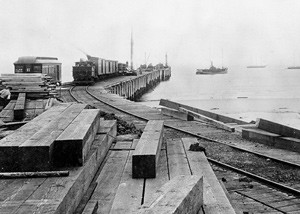
The place of McFadden Wharf was designated a California Historic Landmark (No.794) on July 3, 1964.
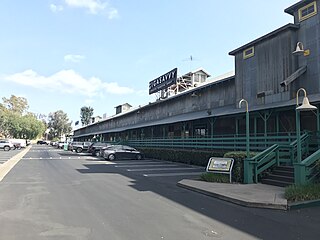
Irvine Bean and Growers Association Building, sometimes referred to as the Sack Storage Warehouse or the Bean Warehouse Building, at 14952 Sand Canyon Ave. in Irvine, California, was built in 1895. It was listed on the National Register of Historic Places in 1986. It was used as a storage facility for trains on the tracks directly to the west of the building. It could up to 200,000 sacks of 100 pounds each holding lima, garbanzo, black-eyed beans, barley, or oats.
